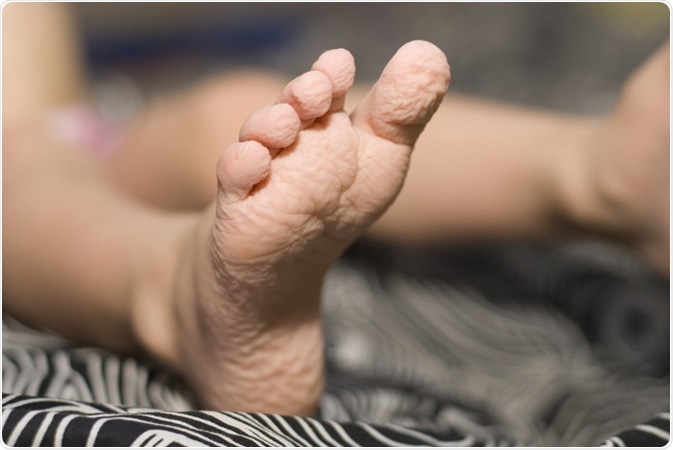Water molecules naturally flow through a semipermeable membrane from a high concentration area to a low concentration area through a process called osmosis. When a person stays in a water bath for a prolonged time, osmosis occurs and the water flows into the upper skin cells, which then take up the water. Shrinking and expanding effects take place simultaneously in these skin cells, causing wrinkles.

Toes wrinkled after bath - Image Credit: Taratorki / Shutterstock
The wrinkling effect mostly pops up on the thickest layer of the skin. This layer is found on the inner surface of the hands and feet due to their constant rubbing against rough surfaces, i.e., the wrinkling effect is greater in hands and feet, where the thickest layer of the skin exists.
For better understanding of this process, knowledge of the anatomy of skin is necessary.
Skin anatomy
The skin has three layers:
- Inner(deepest) layer/subcutaneous tissue – made of fats and connective tissue
- Middle layer/dermis – contains blood vessels, nerves, hair roots, and sweat glands
- Outermost layer/epidermis – protects the internal layers from harm and avoids evaporation of water from the body
The epidermis has four sub-layers:
- The stratum corneum
- Granular layer
- Squamous cell layer
- Basal cell layer
In the epidermis, newly formed cells (nucleus) stay at the bottom while the older cells (involutes) are pushed upward continuously to form a dead keratin cell layer. This is a continuous or programmed cell death process that happens on the skin in the human life cycle.
The stratum corneum is the part that one can see and feel, and is made of dead keratin cells. These cells are responsible for the formation of wrinkles in the fingers and toes. Keratin is a protein that is also found on nails and hair.
Facts about wrinkling
Researchers believe that some reactions controlled by the autonomic nervous system result in wrinkling in the fingers or toes. Two cases that likely play a vital role in skin wrinkling due to soaking in water are explained.
Case 1: The outermost layer of the skin is provided with sebum oil, which protects, lubricates, and moistens the skin. This oil layer acts as a waterproof on our skin and so, when we wash our hands the water runs off. However, spending a longer time in water washes away the sebum and the water is able to penetrate into the outermost layer of the skin, and thereby cause wrinkles.
Case 2: The skin is majorly comprised of keratin (especially in fingers and toes), therefore it absorbs water when in contact with it for long. This is a normal biological mechanism that causes wrinkles. These wrinkles are technically called aquatic wrinkles.
This type of wrinkling of the skin happens due to digital vasoconstriction, which is a process of narrowing of blood vessels. When the hand is soaked in water, the nerve fiber in the skin shrinks and the body temperature regulator (glomus bodies in the skin) in the hand loses its volume. Thus the epidermis of the skin is pulled downward, forming wrinkles. At present, the role of digital vasoconstriction is under investigation.
Why not in other Parts?
- There are more keratin cells in the epidermis of the hands and feet (especially fingers and toes) than in the other parts of the body. Therefore, bunching up of the skin is less in other parts and so wrinkling does not happen there.
- Although our nails and hair are also made of keratin, they absorb little water while bathing, and so they do not shrink in volume, instead they get softer.
When will it not happen?
Wrinkling will not happen to a finger or toe that has a sympathetic nerve cut, even if you soak them for the whole day. This is due to the nerve function loss that happens due to the cut.
People with other disorders or those with replanted amputated fingers that has resulted in nerve function loss will also show no wrinkling after soaking the fingers in water.
Advantage of wrinkled skin
Initially, it was thought that due to wrinkly skin, the sensitivity of the fingertip is reduced and damage to skin is increased.
In a recent study conducted on a sample population in three different contexts - normal, dry, and wrinkly hands (formed from soaking in warm water for 30 min), the participants were able to pick up wet marbles more quickly with wrinkled fingers. The study concluded that wrinkled fingers provide a better grip for holding objects.
A similar effect in the toes gives us a better grip while walking in the rain.
Studies also state that wrinkled fingers might have served an added advantage for our human ancestors to collect wet vegetables and food from streams.
What to do when we get wrinkles?
Fortunately, this is a temporary phenomenon. Aquatic wrinkles disappear rapidly and the skin returns to the normal state once the water in the fingers or toes has completely evaporated.
Further Reading